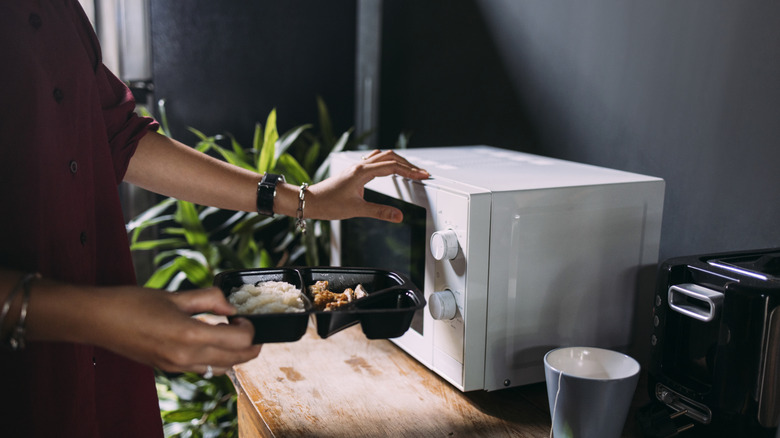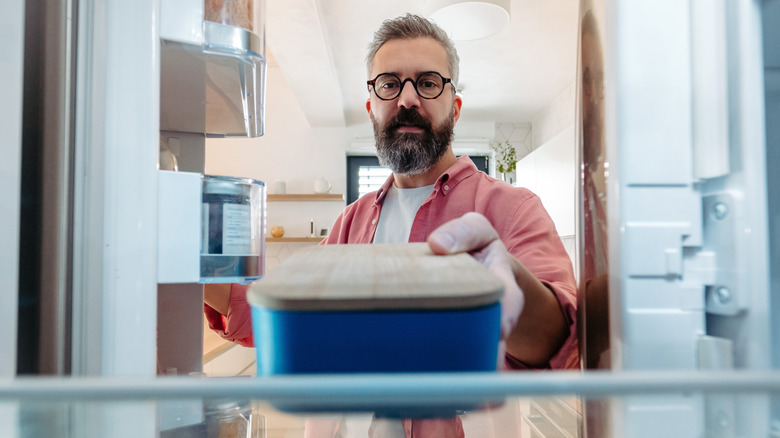The Dangerous Takeout Mistake You Never Knew Could Make You Sick
Chances are, you may have ordered takeout or delivery recently. According to Market.us Scoop, about 60% of U.S. customers make online food orders at least two times a week. And, if you had leftovers, you might have opted to put them into the refrigerator for later, especially if they came in a nice, sturdy plastic container. After all, it's nice not having to wash any dishes, and it will be convenient to reheat it in the microwave later.
However, if this is your habit, you may want to reconsider, say food safety experts. Shanina Knighton, an associate professor at Case Western Reserve University, told Well & Good the reason is that these containers are made up of chemicals like microplastics, phthalates, and bisphenol-A (BPA).
"When these plastics are heated, they can break down and release harmful chemicals into your food, increasing your exposure to toxins," she observed. "The hotter, greasier, or more acidic your food is, the more likely these chemicals will leach into your meal," Knighton added. (Here's another reason to think twice before reheating oily foods in the microwave.)
Why the chemicals in plastic takeout containers might make you sick
According to the Stanford Report, it's believed that people consume about as much microplastic each week as is found in a credit card. Although the full effects on human health are still being studied, research involving animals and human cells suggests microplastics may be linked to cancer, cardiovascular problems, and fertility concerns. (Learn the surprising way scientists can detect microplastics in our bodies.)
As for phthalates, WebMD notes that research shows these chemicals may disrupt several organ systems and negatively impact both reproductive health and child development. One study even identified a connection between elevated phthalate exposure and an increased risk of early death in older adults.
Finally, BPA has been linked to a number of health conditions, including male and female infertility, obesity, heart disease, type 2 diabetes, certain cancers (ovarian, breast, prostate, and colon), birth defects, and a range of childhood health problems. There is also evidence from test-tube studies that it might make chemotherapy less effective.
How to store and reheat your takeout leftovers safely
Storing leftovers in glass, stainless steel, and ceramic containers can help you avoid the potential dangers associated with plastic. The U.S. Department of Agriculture (USDA) explains that cooked foods should be refrigerated within two hours of preparation. Otherwise, they need to be thrown away since harmful bacteria can rapidly multiply at room temperature. Leftover foods should be placed in an airtight package or sealed in a storage container in order to keep bacteria from getting in. This will also keep your leftovers moist and free from fridge odor. If you know you won't eat them within three to four days, they can be frozen for around three to four months.
To reheat frozen leftovers safely, the USDA advises thawing them first using one of three methods: in the refrigerator (slow but safest), in cold water (faster but requires care to avoid contamination), or in the microwave (quickest, but food must be cooked immediately to 165 degrees Fahrenheit). You can also reheat frozen leftovers without thawing, though it will take longer. Leftovers that have been kept in the fridge can go directly into the microwave.
Always ensure food reaches an internal temperature of 165 degrees Fahrenheit. Use a food thermometer, cover dishes to retain moisture, and stir or rotate food for even heating, especially in the microwave, which can leave cold spots. Lastly, never microwave food in plastic unless the containers are specifically labeled as being safe for this purpose.


